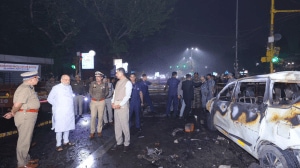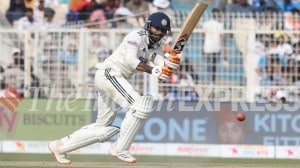The killing roads
Last week,14-year-old Aditya Jain died on his way to school in Delhi. He was at a bus stand when a Blueline knocked him down.
Last week,14-year-old Aditya Jain died on his way to school in Delhi. He was at a bus stand when a Blueline knocked him down. In India,home to the highest number of road deaths in the world,the young put their lives in danger by stepping out on the roads: those between the age of 10 and 50 years are more likely to die of road crashes than any other disease.
Traffic experts hope that the first ever Global Ministerial Conference on road safety,which starts in Moscow on Thursday,can nudge the crisis on Indias roads on to the agenda of its political class. We want ministers who attend the conference to accept the seriousness of the problem,agree on the way forward and go back to their countries and act, said Rohit Baluja,president of the Delhi-based Institute for Road Traffic Education (IRTE),an NGO. and a member of the Commission for Global Road Safety.
The conference is being organised on the request of the UN General Assembly and calls for a decade of action to bring down road deaths across the world by 50 per cent by 2020. Union Minister of Road,Transport and Highways Kamal Nath will not attend the meet.
In 2007,according to the National Crime Records Bureau (NCRB),around 1.15 lakh Indians died due to road accidents,making it the country with the highest number of road fatalities. Last year,165 people were killed in the Mumbai attacks; around 315 die on roads each day. No day is exempt from carnage,with 13 deaths an hour.
Whats more worrying is that the rate of road deaths has been rising by 8 per cent every year. If nothing is done to check it now,rates can go up by four times, said Dinesh Mohan of the Transportation Research and Injury Prevention Programme (TRIPP) at IIT-Delhi.
A conservative estimate is that the financial cost of these deaths and injuries is 3 per cent of what the GDP was in 2000 or Rs 55,000 crore. While successive governments have pumped in crores into building roads over the years,a pittance has been invested in road safety. Joint Secretary of the Ministry of Road,Transport and Highways S K Dash,who will represent India at the Moscow conference,said,The money spent on road safety is not even 1 per cent of the amount spent on building roads. Its much,much less. Road deaths have never been on the agenda of any political party.
Vulnerable road users pedestrians,bicyclists and motorised two-wheeler riders are the biggest victims of road crashes. In cities,50 per cent of victims are pedestrians,20-25 per cent are motorcycle riders,10-15 per cent are cyclists. Car users constitute less than 10 per cent of the victims. Yet,in most cities,road design consistently puts speed before safety and pedestrian facilities. More men die in road accidents than women. A bigger chunk of those who die on roads are the urban and rural poor.
An IRTE survey last year found 146 million traffic violations on Delhis roads every day,of this only one in 30,000 were booked.
The figures hide another story. The WHO estimates that for every death due to a road accident,the number of injured is 20. But according to the NCRB,4.5 lakh were injured in road accidents in 2007. Studies suggest 80 per cent of injuries dont make it to hospital records. An estimated 20 lakh people have been disabled due to road accidents.
Highways are the fastest way to bring mobility and development to remote corners. They are also the most dangerous stretches,accounting for 2 per cent of Indias road network and half or more of all road deaths. Studies on some highways have shown that smoother,faster roads encourage speeding and lead to more deaths. All our national highways have ignored international road safety standards, said Mohan. Its an assessment senior government officials agree with.
In the hundreds of cases where highways have split villages into two,deaths have gone up,forcing villagers to build speedbreakers on their own. Alarmingly,in smaller cities such as Agra,Meerut and Asansol,death rates have gone up by three times in the last five-six years.
One of the major recommendations of the WHO report is to put in place an institutional mechanism to deal with road safety. Two years ago,the Sundar committee on road safety submitted a report and recommended a central agency for traffic deaths. After months of lying with the Law Ministry,the proposal to create a National Road Safety and Traffic Management Board has been cleared. All that remains is for the minister to sign it, said Dash.
Across the world,unless there is a government agency to tackle road safety,no progress has been made. If Mr Kamal Nath can steer this through Parliament,it will be the most important historical intervention for road safety in the country, said Mohan. Its about time.
Slow down
Pedestrians have a 90 per cent chance of surviving a car crash at 30km/h or below,but less than 50 per cent chances of surviving impacts of 45km/h or above
A 5 per cent increase in average speed leads to an approximately 10 per cent increase in crashes that cause injuries and a 20 per cent increase in fatal crashes
Speed is a key risk factor for injury among pedestrians and cyclists,and yet only 29 per cent of countries meet basic criteria for reducing speed in urban areas,while less than 10 per cent of countries rate the enforcement of their speed limits as effective
What can be done now
Make it mandatory for two-wheelers to have their headlights on even in the day. All European countries have such a law; Thailand,Indonesia and Singapore have recently enacted it. This can bring down deaths by 15 per cent
Discourage parents from carrying a child in their lap,especially when they are in the front-seat of a car. Children should always be in the back seat
Ban free left turns in cities
Check drunken driving by random tests
Policy suggestions
Governments need to take into consideration the needs of all road users when making policy decisions that impact on road safety. Needs of vulnerable road users have been neglected in many countries and should be given renewed emphasis
Identify/set up a lead government agency to guide the national traffic safety report
Set up systems for exhaustive data collection on traffic accidents and centres for research in traffic engineering and design
Ensure special facilities for slow and local traffic along highways































